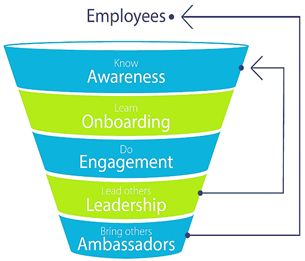Introduction
A workplace is a location where someone works for their employer or themselves, i.e., a place of employment. Such a place can range from a home office to a large office building or factory. A typical workplace is made up of the following category of people, viz:
- Management
Management is a tool or process for businesses to organize and direct workflow, operations, and employees to meet corporate goals. When viewed as an administrative structure, the primary goal of management is to create an environment that lets employees work efficiently and productively. A solid organizational structure serves as a guide for workers and establishes the tone and focus of their work.
- Employee
An employee is an individual that works for another person or a business firm for an agreed remuneration. An employee performs a set of tasks as directed by management and his or her performance is monitored and evaluated by a manager.
- Supervisor
A supervisor is a professional who takes a leadership role in an organisation and manages a team of employees. As a supervisor, you may be responsible for doing any of the following tasks:
- Create goals and objectives
- Create schedules
- Develop strategies to increase performance, productivity, and efficiency
- Monitor budgets, productivity levels, and performance
- Ensure compliance with company policies and industry regulations
- Mentor employees
- Resolve customer problems
- Train employees
1. Levels of management
In many organisations, management falls into one of three levels: top, middle, and low. Managers in smaller companies may fill roles at more than one level, while larger organizations may have several managers within each level.
- Top level management: typically has an
administrative role, and their decisions affect the entire
organisation even though they sometimes are not involved in the
day-to-day operations. They may have the title of chief executive
officer (CEO), managing partner or serve on a board of
directors.
- Middle level management: employees with
executive roles are usually found at the middle management level.
They work with both top-level management and supervisors to help
workers meet objectives and boost the company's productivity.
At this level, they may be called regional managers or general
managers.z
- Low level management: this final level of management often has a supervisory role. They work with individuals and teams to meet goals determined by upper management. They typically have less influence over company policy compared to the other management levels, but the most interaction with workers.
2. Management styles
The way you choose to manage your team or department can have a direct effect on how the team or department are able to meet their goals. What you say and do may send powerful messages to employees about how you value their contributions and your level of trust in them. Understanding different management styles and when they are most and least useful may be helpful. The list below highlights some of the more common styles used by managers.
- Authoritative: Authoritative leaders tend to
make decisions without feedback from others. This approach works
well when you need to respond quickly to a situation with little
room for debate. If you rely on this approach excessively, you may
see high levels of turnover within the organization and stalled
innovation.
- Coaching: Some managers view their role as that of a coach who sees the potential in employees and wants to help them grow. This can effectively build strong teams and create an environment where employees feel comfortable experimenting. Employees typically have a sense of autonomy under this style, but those who need more direction may feel some neglect.
- Democratic: Democratic managers value the
input of employees in the decision-making process and usually
believe having more ideas is better than having a few. This
management style may help empower employees and increase their
motivation to work toward common goals. However, sorting through
all of the voices and finding a consensus to make a decision can
take time.
- Transformational: In a transformational
management style, managers prioritise innovation and growth. These
managers encourage employees to discover just what they are capable
of achieving. Workers with transformational leaders tend to be
happy and dedicated to their work, but they must be able to adapt
to sudden changes.
- Visionary: A visionary leader knows how to ensure every team member understands the company's vision and is working toward a common goal. These leaders tend to be excellent communicators and typically give workers plenty of autonomy as long as they effectively execute the vision.
3. Employee engagement
Employee engagement describes the level of enthusiasm and dedication a worker feels toward their job. Employee engagement can be critical to a company's success, given its links to job satisfaction and employee morale. Engaged employees are more likely to be productive and higher performing.
Maslow's theory1 of employee engagement posits that fulfilling each of the five basic human needs: physiological, safety, love and belonging, esteem and self-actualisation leads to higher employee engagement and motivation.
4. Employee Engagement Funnel
The employee engagement funnel is a symbolic visualisation of how employees become aware of corporate goals, learn more about the company, and change how they do their job and how other employees do it, too.
The employee engagement funnel does not involve screening employees or reviewing their performance. It is about engaging them with their work and the goals of the organisation.
The employee engagement funnel goes from:
- Awareness
- Onboarding
- Engagement
- Leadership
- Ambassadors

Image culled from: www.elearningindustry.com2
As employees move through the funnel, their value to the organisation becomes exponentially higher and their job satisfaction will grow commensurately.
5. How can organisations harness the employee engagement funnel?
- Awareness: First, we need to create awareness
of corporate goals or changes that need employees' attention.
Sometimes segmenting employees into audiences does the trick.
Awareness is also about culture. Most organizations would benefit
from a culture of awareness and engagement.
- Onboarding: During this phase, employees learn
more about the company's strategy and activities both at the
team and personal level.
- Engagement: During this phase, employees
usually have the requisite knowledge, but it is not enough. The
knowledge has to be integrated with the employee's prior
knowledge and combined, sometimes creatively, with other offerings
available to the company. This requires an emotional commitment
since the employee needs to get out of their comfort zone.
- Leadership: Leaders are not always managers;
they are usually active people in the community. What they do is
help others get into the engagement level by onboarding them and
helping them integrate the new learning into their day to day
work.
- Ambassadors: Ambassadors break the walls of their close environment. They become evangelists speaking about the organisation to others and projecting the unique attributes and offerings of the organisation.
6. The impact of managers on employee engagement
A manager's job is to keep their team engaged and laser-focused on the tasks at hand. Sometimes, however, managers can be the primary reason for disengagement in the first place. Managers giving little or no feedback results in four out of ten people becoming actively disengaged. Regular, developmental feedback not only builds trust, but it also helps people deliver on their promises.
People normally leave their managers, not their job. And the evidence certainly supports this theory. According to data published in The Economist3, 35% of American people employed would forego a pay rise to get their boss fired.
Managers have a massive impact on employee engagement, happiness, and health. Productivity is also affected by poor management. The relationship between managers and their team is changing. People are no longer just human resources, and managers are increasingly becoming aware of the importance of understanding, acknowledging, and accommodating their team's personal lives.
7. What makes a good manager?
The following are traits of a good manager:
- A good coach
- Empowers the team and does not micromanage
- Expresses an interest in and concern for team members' success and personal well-being
- Is productive and results-oriented
- Is a good communicator who listens and shares information
- Helps with career development
- Has a clear vision and strategy for the team
- Has key technical skills that help them advise the team
- A good collaborator
- Makes decisions with the team's welfare in mind.
It is no longer enough for managers to merely fulfill basic administrative duties. A good manager must be deeply empathetic and genuinely interested in their team's personal lives and long-term careers. They need to be supportive, open-minded communicators as well as being deeply intuitive, but they must not micromanage. To understand and connect with their team, managers need to understand them as individual people. Engagement boils down to treating people with respect.
8. How managers can boost employee engagement
Managers can do the following to bolster great engagement among their team:
- Provide honest, constructive feedback: Giving
feedback is vital because it is a constructive and important way to
help employees get better at what they do. Regular, developmental
feedback not only builds trust, but it also helps people deliver on
their promises.
- Give regular recognition: Providing praises
and recognition helps increase the feelings of self-worth and
self-esteem in employees.
- Build and maintain positive relationships: We spend most of our time at work. So, it is only reasonable to encourage employees to build and maintain meaningful relationships with their colleagues. Managers want people around them to feel connected to what the business does. In order to achieve this, the first step is to encourage cooperation and build positive relationships between colleagues.
9. Conclusion
Making sure your employees stay engaged is not merely 'a nice-to-have' attribute, it is a must for any thriving business. Companies with engaged employees are far more productive and up to 22% more profitable than those with a disengaged workforce4.
In bolstering engagement across a business, the role of managers is vital. As one of the key indicators of people's wellbeing, managers need to be given the training and support to properly manage their teams. And, perhaps most importantly, businesses need to ensure they treat all their people with respect.
Engaged workers are essential to your bottom line, but more than that, engaged employees spread positivity, provide better customer service and are more loyal to your company. It therefore makes business sense in more ways than one, to focus time and attention on engaging your employees.
Footnotes
1. See https://canadacollege.edu/dreamers/docs/Maslows-Hierarchy-of-Needs.pdf accessed 23rd August 2023 and https://www.seenit.io/blog/top-5-employee-engagement-models-theories-to-follow/ accessed 23rd August 2023.
2. Available at https://elearningindustry.com/using-employee-engagement-funnel-gamification-business-transformation accessed 21st August 2023.
3. Available at https://www.quora.com/Did-35-of-American-workers-say-they-would-forgo-a-pay-raise-in-exchange-for-having-their-boss-fired accessed at 23rd August 2023.
4. Available at https://www.seenit.io/blog/top-5-employee-engagement-models-theories-to-follow/ accessed on 23rd August 2023.
The content of this article is intended to provide a general guide to the subject matter. Specialist advice should be sought about your specific circumstances.

